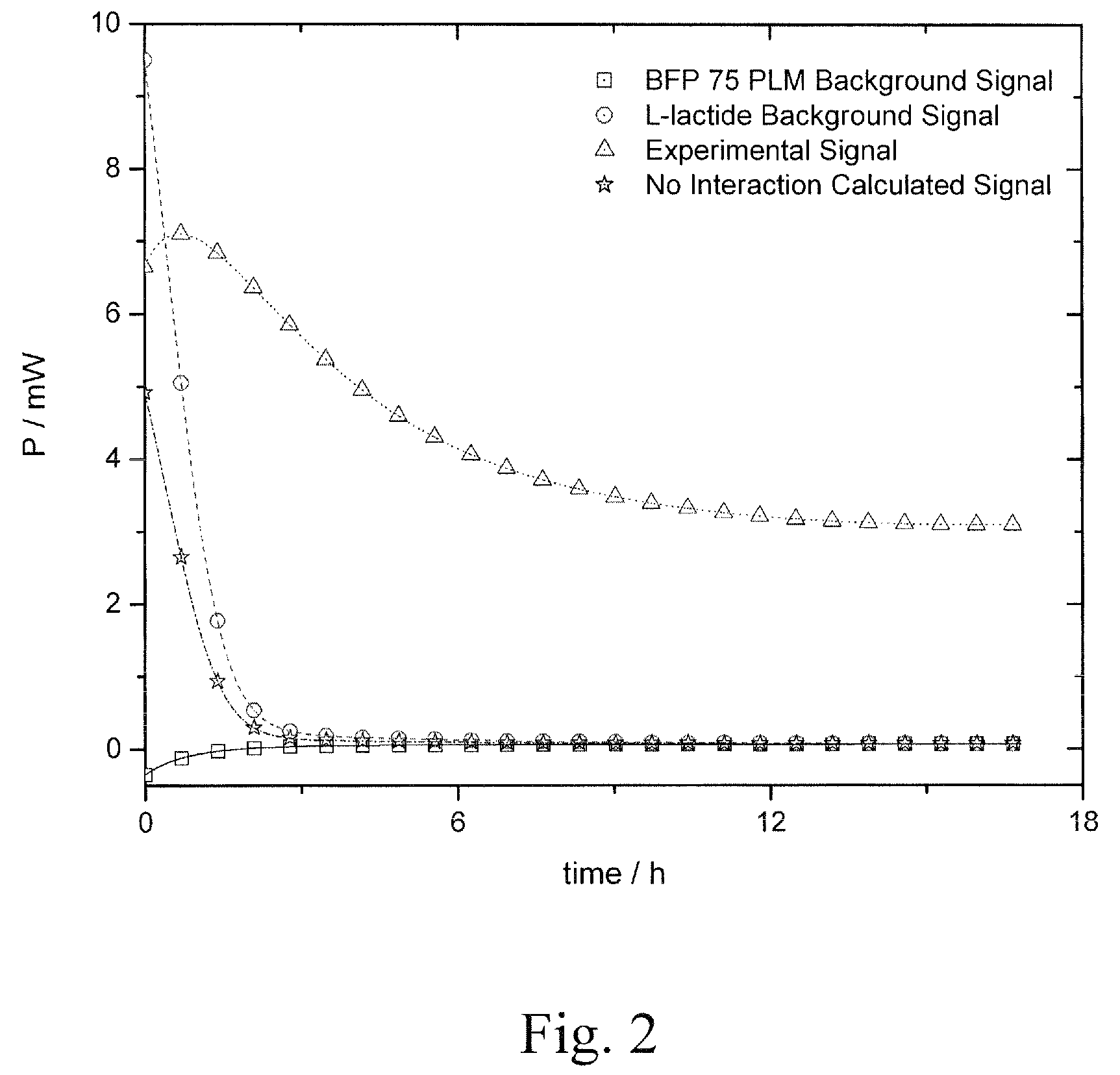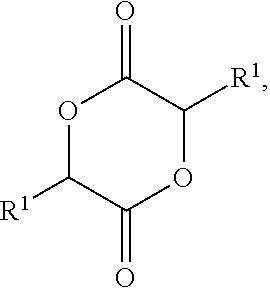Lactylate synthesis methods using dilactides
a technology of dilactide and lactylate, which is applied in the preparation of carboxylic acid esters, chemistry apparatus and processes, organic chemistry, etc., can solve the problems of lactic acid availability and price limitations, slow process,
- Summary
- Abstract
- Description
- Claims
- Application Information
AI Technical Summary
Benefits of technology
Problems solved by technology
Method used
Image
Examples
example 1
Commercial Sodium Stearate and Slow Addition of L-Lactide
[0096]In this Example, 395.47 g stearic acid and 426.30 g sodium stearate were added to a 4-necked, 2,000 mL round bottom flask equipped with an overhead stirrer (PTFE paddle on a glass rod and Ace Glass trubore) through the center neck. One side neck was topped with a thermometer (−10 to 300° C.), and a second side neck was topped with a nitrogen sparge line (type “A” glass frit on angled glass tube).
[0097]A heating mantle attached to a rheostat was used to heat the flask. Once the stearic acid was melted (˜70° C.), the nitrogen sparge was set to 400 mL / min. The reaction at this point was a suspension of particles in liquid.
[0098]The third side arm was topped with an addition funnel with equilibrating side arm wrapped in silicone heating tapes. The tapes were attached to an analog heat controller. Next, 202.12 g L-lactide was added to the addition funnel and allowed to melt.
[0099]When the reaction temperature reached 179° C.,...
example 2
Lactylate Preparation Using L-Lactide and Commercial Sodium Stearate
[0107]
[0108]In this procedure, 196.68 g stearic acid and 202.80 g sodium stearate were added to a 4-necked, 1,000-mL, round bottom flask equipped with an overhead stirrer (PTFE paddle on a glass rod and Ace Glass trubore) through the center neck. One side neck was topped with a thermometer (−10 to 300° C.) and a second side neck was topped with a nitrogen sparge line (type “A” glass frit on angled glass tube). The third side arm was topped with an addition funnel with equilibrating side arm wrapped in a silicone heating band. The band was connected to a digital temperature controller. A J-type thermocouple was attached to the controller and tucked between the heating band and the addition funnel. A heating mantle attached to a rheostat was used to heat the flask. Once the stearic acid was melted (−70° C.), the nitrogen sparge was set to 400 mL / min.
[0109]Next, 100.52 g L-lactide was added to the addition funnel. The ...
example 3
Lactylate Preparation Using L-Lactide and In Situ Sodium Stearate Generation
[0114]
[0115]A 4-necked, 1,000-mL round bottom flask equipped with an overhead stirrer (PTFE paddle on a glass rod and Ace Glass trubore) through the center neck and containing 393.36 g stearic acid was utilized in this Example. One side neck was topped with a thermometer (−10 to 300° C.), and a second side neck was topped with a nitrogen sparge line (type “A” glass frit on angled glass tube). The third side arm was left open. A heating mantle attached to a rheostat was used to heat the flask. The stearic acid was melted (˜70° C.), and then the nitrogen sparge was set to 700 mL / min.
[0116]Next, 55.80 g of a solution of sodium hydroxide in water (50%) was added to the reaction via the third side arm. Addition was complete at t=7 min., and the temperature was maintained between 100-110° C. The resulting mixture was slightly viscous and opaque.
[0117]The stir rate was increased to minimize foaming. The reaction wa...
PUM
| Property | Measurement | Unit |
|---|---|---|
| temperature | aaaaa | aaaaa |
| temperature | aaaaa | aaaaa |
| temperature | aaaaa | aaaaa |
Abstract
Description
Claims
Application Information
 Login to View More
Login to View More - R&D
- Intellectual Property
- Life Sciences
- Materials
- Tech Scout
- Unparalleled Data Quality
- Higher Quality Content
- 60% Fewer Hallucinations
Browse by: Latest US Patents, China's latest patents, Technical Efficacy Thesaurus, Application Domain, Technology Topic, Popular Technical Reports.
© 2025 PatSnap. All rights reserved.Legal|Privacy policy|Modern Slavery Act Transparency Statement|Sitemap|About US| Contact US: help@patsnap.com



